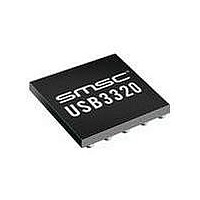USB3300-EZK-TR SMSC, USB3300-EZK-TR Datasheet - Page 40

USB3300-EZK-TR
Manufacturer Part Number
USB3300-EZK-TR
Description
USB Interface IC USB 2.0 PHY ULPI
Manufacturer
SMSC
Type
Hi Speed USB Host Devicer
Datasheet
1.USB3300-EZK.pdf
(55 pages)
Specifications of USB3300-EZK-TR
Maximum Operating Temperature
+ 85 C
Minimum Operating Temperature
- 40 C
Mounting Style
SMD/SMT
Operating Temperature Range
- 40 C to + 85 C
Operating Supply Voltage
3.3 V
Package / Case
QFN-32
Lead Free Status / RoHS Status
Lead free / RoHS Compliant
Available stocks
Company
Part Number
Manufacturer
Quantity
Price
Company:
Part Number:
USB3300-EZK-TR
Manufacturer:
MICRON
Quantity:
3 140
Part Number:
USB3300-EZK-TR
Manufacturer:
MICROCHIP/微芯
Quantity:
20 000
Revision 1.08 (11-07-07)
6.2.3
6.3
SIGNALING MODE
Peripheral LS Resume
Peripheral Test J/Test K
OTG device, Peripheral Chirp
OTG device, Peripheral HS
OTG device, Peripheral FS
OTG device, Peripheral HS/FS Suspend
OTG device, Peripheral HS/FS Resume
OTG device, Peripheral Test J/Test K
Note: This is the same as Table 40, Section 4.4 of the ULPI 1.1 specification.
Bias Generator
This block consists of an internal bandgap reference circuit used for generating the driver current and
the biasing of the analog circuits. This block requires an external 12KΩ, 1% tolerance, external
reference resistor connected from RBIAS to ground.
The USB3300 uses an internal crystal driver and PLL sub-system to provide a clean 480MHz reference
clock that is used by the PHY during both transmit and receive. The USB3300 requires a clean 24MHz
crystal or clock as a frequency reference. If the 24MHz reference is noisy or off frequency the PHY
may not operate correctly.
The USB3300 can use either a crystal or an external clock oscillator for the 24MHz reference. The
crystal is connected to the XI and XO pins as shown in the application diagram,
oscillator is used the clock should be connected to the XI input and the XO pin left floating. When a
external clock is used the XI pin is designed to be driven with a 0 to 3.3 volt signal. When using an
external clock the user needs to take care to ensure the external clock source is clean enough to not
corrupt the high speed eye performance.
Once the 480MHz PLL has locked to the correct frequency it will drive the CLKOUT pin with a 60MHz
clock. The USB3300 is guaranteed to start the clock within the time specified in
Characteristics: CLKOUT
input.
For Host Applications the USB3300 implements the ULPI AutoResume bit in the Interface Control
register. The default AutoResume state is 0 and this bit should be enabled for Host applications. For
more details please see sections 7.1.77 and 7.9 of the USB specification.
Crystal Oscillator and PLL
Table 6.8 DP/DM termination vs. Signaling Mode (continued)
Start-Up". The USB3300 does not support using an external 60MHz clock
10b
00b
00b
01b
00b
01b
01b
00b
DATASHEET
REGISTER SETTINGS
Hi-Speed USB Host, Device or OTG PHY with ULPI Low Pin Interface
1b
0b
1b
0b
1b
1b
1b
0b
40
10b
10b
10b
00b
00b
00b
10b
10b
0b
0b
0b
0b
0b
0b
0b
0b
0b
0b
1b
1b
1b
1b
1b
1b
0b
0b
1b
0b
1b
1b
1b
0b
RESISTOR SETTINGS
1b
0b
0b
0b
0b
0b
0b
0b
Figure
Table 5.2, "Electrical
0b
0b
0b
0b
0b
0b
0b
0b
SMSC USB3300
7.1. If a clock
0b
0b
1b
1b
1b
1b
1b
1b
Datasheet
0b
1b
0b
1b
0b
0b
0b
1b












